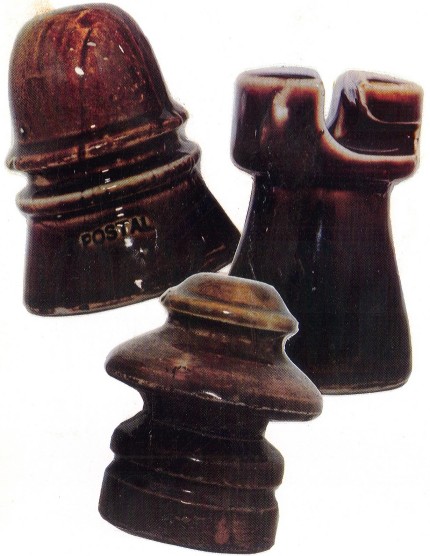May Cover
Reprinted from "Crown Jewels of the Wire", May 1996, page 2
Proving brown glaze is beautiful and that porcelain shapes can be
intriguing, this trio is living proof. Insulators belong to Bob Stahr and were
photographed by John McDougald.

The incuse "POSTAL" marking on the U-154 is clear and bold. Many
examples of this style (which resembles its glass cousin, CD 151) were found
primarily in Illinois and Iowa on lines serving the Postal Telegraph Company. It
is a product of Pittsburg High Voltage.
The August 11, 1914 patented by Benjamin S. Purkey of Tacoma, Washington
covered a "twist-lock" design. Jack H. Tod explains in Porcelain
Insulators, Guide Book for Collectors, Third Edition, "After the insulator
is screwed onto the peg, it is backed off about 1/4 turn and the conductor is
dropped into the crown slot, and the insulator again screwed down to secure the
wire in place. The conductor runs slack-wire through the insulator crown.
Specimens are unattributed as to manufacturer but appear to have been made by
Pittsburg. This is a 3-piece glaze-weld, two identical, reversible parts at the
top glaze-welded to the base part." One should note that the embossing is
on the top of the crown of the U-186 and that it contains a spelling error.

Elton N. Gish shares in Fred M Locke, A Biography that U-220A/B (a two piece
transposition insulator) was probably the first transposition style manufactured
by Fred Locke at his factory in Victor, New York, followed by the simpler
one-part U-192A. The insulator can be found with either incuse marking #0-6 or
#1-4 on the upper surface of the top part. The May 22, 1894 patent date is Fred
Locke's patent for a transposition insulator. CD 204 was his first transposition
insulator based on his patent, then two years later he introduced CD 202.
| #0-6 |
FRED M. LOCKE,
VICTOR, N.Y. |
#1-4 |
PAT'D MAY. 22,1894.
FRED M. LOCKE |
|
